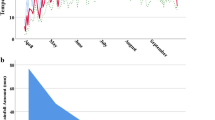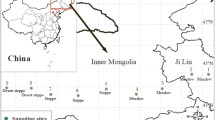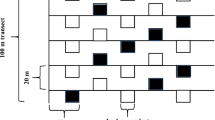Abstract
Cenchrus ciliaris L. is a perennial grass that can grow in a diverse range of habitats including challenging deserts. The purpose of the study was to investigate the impact of aridity on morpho-anatomical and physiological traits in C. ciliaris populations collected from arid and semi-arid areas of Punjab, Pakistan. The populations growing in extremely arid conditions displayed a range of structural and physiological adaptations. Under extremely dry conditions, root epidermal thickness (90.29 µm), cortical cell area (7677.78 µm2), and metaxylem cell area (11,884.79 µm2) increased while root pith cell area (2681.96 µm2) decreased in tolerant populations. The populations under extremely aridity maximized leaf lamina (184.21 µm) and midrib thickness (316.46 µm). Additionally, highly tolerant populations were characterized by the accumulation of organic osmolytes such as glycinebetaine (132.60 µmol g−1 FW) was increased in QN poulations, proline (118.01 µmol g−1 F.W) was maximum in DF populations, and total amino acids (69.90 mg g−1 FW) under extreme water deficit conditions. In arid conditions, abaxial stomatal density (2630.21 µm) and stomatal area (8 per mm2) were also reduced in DF populations to check water loss through transpiration. These findings suggest that various parameters are crucial for the survival of C. ciliaris in arid environments. The main strategies used by C. ciliaris was intensive sclerification, effective retention of ions, and osmotic adjustment through proline and glycinebetaine under arid conditions.










Similar content being viewed by others

Availability of data and materials
All data supporting the findings of this study are available within the paper and its Supplementary Information.
References
Abdel Razik ES, Alharbi BM, Pirzadah TB, Alnusairi GS, Soliman MH, Hakeem KR (2021) γ-Aminobutyric acid (GABA) mitigates drought and heat stress in sunflower (Helianthus annuus L.) by regulating its physiological, biochemical and molecular pathways. Physiol Plant 172(2):505–527
Ahlem A, Lobna MF, Mohamed C (2023) Soil water leaf gas exchange and biomass production of Buffelgrass (Cenchrus ciliaris L.) with two ploidy levels under arid zone. Acta Ecol Sin 43(3):506–512
Ahmad ST, Haddad R (2011) Study of silicon effects on antioxidant enzyme activities and osmotic adjustment of wheat under drought stress. Czech J Genet Plant Breed 47(1):17–27
Ahmad MSA, Hussain M, Saddiq R, Alvi AK (2007) Mungbean: a nickel indicator, accumulator or excluder? Bull Environ Contam Toxicol 78(5):319–324
Ahmad KS, Wazarat A, Mehmood A, Ahmad MSA, Tahir MM, Nawaz F, Ahmed H, Zafar M, Ulfat A (2020) Adaptations in Imperata cylindrica (L.) Raeusch. and Cenchrus ciliaris L. for altitude tolerance. Biologia 75(2):183–198
Akcin TA, Akcin A, Yalcın E (2017) Anatomical changes induced by salinity stress in Salicornia freitagii (Amaranthaceae). Brazil J Bot 40:1013–1018
Al-Dakheel AJ, Hussain MI (2016) Genotypic variation for salinity tolerance in Cenchrus ciliaris L. Front in Plant Sci 7:1090
Ali T, Nafees M, Maqsood A, Naqvi SA, Shahzad U, Haider MS, Aslam MN, Shafqat W, Hameed M, Khan IA, Ahmar S (2020) Contribution of root anatomical characteristics in fruit profile of pomegranate genotypes to expand production area in Pakistan. Agron 10(6):810
Al-maskri A, Hameed M, Ashraf M, Khan MM, Fatima S, Nawaz T, Batool R (2014) Structural features of some wheat (Triticum spp.) landraces/cultivars under drought and salt stress. Arid Land Res Manag 28(3):355–370
Anandan S, Rudolph A, Speck T, Speck O (2018) Comparative morphological and anatomical study of self-repair in succulent cylindrical plant organs. Flora 241:1–7
Arnon DI (1949) Copper enzymes in isolated chloroplasts. Polyphenoloxidase in Beta Vulgaris. Plant Physiol 24(1):1
Asghar N, Akram NA, Ameer A, Shahid H, Kausar S, Asghar A, Idrees T, Mumtaz S, Asfahan HM, Sultan M, Jahangir I (2021) Foliar-applied hydrogen peroxide and proline modulates growth, yield and biochemical attributes of wheat (Triticum aestivum L.) Under varied n and p levels. Fresenius Environ Bull 30:5445–5465
Bakhshandeh E, Gholamhosseini M, Yaghoubian Y, Pirdashti H (2020) Plant growth promoting microorganisms can improve germination, seedling growth and potassium uptake of soybean under drought and salt stress. Plant Growth Regul 90(1):123–136
Baltas E (2007) Baltas Spatial distribution of climatic indices in northern Greece. A J Forecast Pract Appl Train Tech Model 14(1):69–78
Bates LS, Waldren RP, Teare ID (1973) Rapid determination of free proline for water-stress studies. Plant Soil 39(1):205–207
Berdugo M, Delgado-Baquerizo M, Soliveres S, Hernández-Clemente R, Zhao Y, Gaitán JJ, Gross N, Saiz H, Maire V, Lehmann A, Rillig MC (2020) Global ecosystem thresholds driven by aridity. Sci 367:787–790
Coscarelli RO, Gaudio RO, Caloiero T (2004) Climatic trends: an investigation for a Calabrian basin (southern Italy). IAHS 286:255–266
Efeoğlu B, Ekmekçi Y, Çiçek N (2009) Physiological responses of three maize cultivars to drought stress and recovery. S Afr J Bot 75(1):34–42
Farooq M, Wahid A, Kobayashi NSMA, Fujita, DBSMA, Basra, SMA (2009) Plant drought stress: effects, mechanisms and management. In: Sustainable agriculture. Springer, Dordrecht, pp 153–188
Fatima S, Hameed M, Ahmad F, Ashraf AR (2018) Structural and functional modifications in a typical arid zone species Aristida adscensionis L. along altitudinal gradient. Flora 249:172–182
Gill SS, Gill R, Anjum NA (2014) Target osmoprotectants for abiotic stress tolerance in crop plants—glycine betaine and proline. In: Plant adaptation to environmental change: Significance of amino acids and their derivatives, pp 97–108
Grieve CM, Grattan SR (1983) Rapid assay for determination of water soluble quaternary ammonium compounds. Plant Soil 70(2):303–307
Gupta SK, Bansal R, Gopalakrishna T (2014) Development and characterization of genic SSR markers for mungbean (Vigna radiata (L.) Wilczek). Euphytica 195:245–258
Hameed M, Ashraf M, Naz N (2011) Anatomical and physiological characteristics relating to ionic relations in some salt tolerant grasses from the Salt Range, Pakistan. Acta Physiol Plant 33:1399–1409
Hamid A, Singh S, Agrawal M, Agrawal SB (2020) Effects of plant age on performance of the tropical perennial fodder grass, Cenchrus ciliaris L. subjected to elevated ultraviolet-B radiation. Plant Biol 22:805–812
Hashmat S, Shahid M, Tanwir K, Abbas S, Ali Q, Niazi NK, Akram MS, Saleem MH, Javed MT (2021) Elucidating distinct oxidative stress management, nutrient acquisition and yield responses of Pisum sativum L. fertigated with diluted and treated wastewater. Agric Water Manag 247:106720
Horie T, Karahara I, Katsuhara M (2012) Salinity tolerance mechanisms in glycophytes: an overview with the central focus on rice plants. Rice 5(1):1–18
Hussain I, Saleem MH, Mumtaz S, Rasheed R, Ashraf MA, Maqsood F, Rehman M, Yasmin H, Ahmasghared S, Ishtiaq M, Anwar S (2022) Choline chloride mediates chromium tolerance in spinach (Spinacia oleracea L.) by restricting its uptake in relation to morpho-physio-biochemical attributes. J Plant Growth Regul 41:1594–1614
Imran M, Sun X, Hussain S, Rana MS, Saleem MH, Riaz M, Tang X, Khan I, Hu C (2021) Molybdenum supply increases root system growth of winter wheat by enhancing nitric oxide accumulation and expression of NRT genes. Plant Soil 459(1):235–248
Iqbal U, Hameed M, Ahmad F, Ahmad MSA, Ashraf M, Kaleem M, Shah SMR, Irshad M (2022) Contribution of structural and functional modifications to wide distribution of Bermuda grass Cynodon dactylon (L) Pers. Flora 286:151973
Javid K, Akram MAN, Ranjha MM, Pervaiz S (2020) GIS-based assessment of aridity over Punjab Province, Pakistan, by using climatic indices Arab. J Geosci 13(7):1–12
Joshi R et al (2016) Transcription factors and plants response to drought stress: current understanding and future directions. Front Plant Sci 7:1029
Kaleem M, Hameed M (2021) Functional traits for salinity tolerance in differently adapted populations of Fimbristylis complanata (Retz.). Int J Phytoremediation 23:1–14
Killi D, Bussotti F, Raschi A, Haworth M (2017) Adaptation to high temperature mitigates the impact of water deficit during combined heat and drought stress in C3 sunflower and C4 maize varieties with contrasting drought tolerance. Physiol Plant 159(2):130–147
Lian X, Piao S, Chen A, Huntingford C, Fu B, Li LZ, Huang J, Sheffield J, Berg AM, Keenan TF, McVicar TR (2021) Multifaceted characteristics of dryland aridity changes in a warming world. Nat Rev Earth Environ 2(4):232–250
Liu C, Li Y, Xu L, Chen Z, He N (2019) Variation in leaf morphological, stomatal, and anatomical traits and their relationships in temperate and subtropical forests. Sci Rep 9(1):1–8
Lowry OH (1951) Protein measurement with the Folin phenol reagent. J Biol Chem 193:265–275
Mansoor U, Fatima S, Hameed M, Naseer M, Ahmad MSA, Ashraf M, Waseem AFM (2019) Structural modifications for drought tolerance in stem and leaves of Cenchrus ciliaris L. ecotypes from the Cholistan Desert. Flora 261:151485
Marshall VM, Lewis MM, Ostendorf B (2012) Buffel grass (Cenchrus ciliaris) as an invader and threat to biodiversity in arid environments: a review. J Arid Environ 78:1–12
Mganga KZ, Kuhla J, Carminati A, Pausch J, Ahmed MA (2023) Leaf gas exchange characteristics, biomass partitioning, and water use efficiencies of two C4 African grasses under simulated drought. Grassland Rese 2(1):37–45
De Micco V, Aronne G (2012) Morpho-anatomical traits for plant adaptation to drought. In: Plant responses to drought stress. Springer, Berlin, pp 37–61
Moore S, Stein WH (1948) Photometric nin-hydrin method for use in the ehromatography of amino acids. J Biol Chem 176:367–388
Mukhtar N, Mansoor H, Muhammad A, Rashid A (2013) Modifications in stomatal structure and function in Cenchrus ciliaris L. and Cynodon dactylon (L.) Pers. in response to cadmium stress. Pak J Bot 45:351–357
Mumtaz S, Hameed M, Ahmad F, Sadia B (2019) Structural and functional modifications in osmoregulation for ecological success in purple nutsedge (Cyperus rotundus). Int J Agri Biol 22:1123–1132
Mumtaz S, Hameed M, Ahmad F, Ahmad MSA, Ahmad I, Ashraf M, Saleem MH (2021a) Structural and functional determinants of physiological pliability in kyllinga brevifolia rottb. for survival in hyper-saline saltmarshes. Water Air Soil Pollut 232:1–21
Mumtaz S, Saleem MH, Hameed M, Batool F, Parveen A, Amjad SF, Mahmood A, Arfan M, Ahmed S, Yasmin H, Alsahli AA (2021b) Anatomical adaptations and ionic homeostasis in aquatic halophyte Cyperus laevigatus L. under high salinities. Saudi J Biol Sci 28:2655–2666
Nawaz T, Hameed M, Ashraf M, Batool S, Naz N (2013) Modifications in root and stem anatomy for water conservation in some diverse blue panic (Panicum antidotale Retz.) ecotypes under drought stress. Arid Land Res Manag 27:286–297
Parida AK, Jha B (2013) Inductive responses of some organic metabolites for osmotic homeostasis in peanut (Arachis hypogaea L.) seedlings during salt stress. Acta Physiol Plant 35:2821–2832
Purushothaman R, Zaman-Allah M, Mallikarjuna N, Pannirselvam R, Krishnamurthy L, Gowda CLL (2013) Root anatomical traits and their possible contribution to drought tolerance in grain legumes. Plant Prod Sci 16(1):1–8
Rehman M, Liu L, Bashir S, Saleem MH, Chen C, Peng D, Siddique KH (2019) Influence of rice straw biochar on growth, antioxidant capacity and copper uptake in ramie (Boehmeria nivea L.) grown as forage in aged copper-contaminated soil. Plant Physiol Biochem 138:121–129
Ruzin SE (1999) Ruzin Plant microtechnique and microscopy. Oxford University Press, New York, p 322
Saeidi M, Abdoli M (2015) Effect of drought stress during grain filling on yield and its components, gas exchange variables, and some physiological traits of wheat cultivars. J Agric Sci Technol 17(4):885–898
Sarwar Y, Asghar A, Hameed M, Fatima S, Ahmad F, Ahmad MSA, Ashraf M, Shah SMR, Basharat S, Irshad IUM (2022) Structural responses of differentially adapted Cenchrus setigerus Vahl ecotypes to water deficit. Environ Exp Bot 194:104746
Shehzad M, Gul RS, Rauf S, Clarindo WR, Al-Khayri JM, Hussain MM, Munir H, Ghaffari M, Hussain NSM (2021) Development of a robust hydroponic method for screening of sunflower (Helianthus annuus L.) accessions for tolerance to heat and osmotic stress. Sci Rep 11:1–14
Singhal VP, Mehar SK (2020) Effect of limited nutrient availability on the development and relevance of root cortical aerenchyma. Plant Arch 20:1284–1288
Sun X, Chen F, Yuan L, Mi G (2020) The physiological mechanism underlying root elongation in response to nitrogen deficiency in crop plants. Planta 251(4):1–14
Tadayyon A, Nikneshan P, Pessarakli M (2018) Effects of drought stress on concentration of macro-and micro-nutrients in Castor (Ricinus communis L.) plant. J Plant Nutr 41:304–310
Van den Berg L, Zeng YJ (2006) Response of South African indigenous grass species to drought stress induced by polyethylene glycol (PEG) 6000. S Afr J Bot 72:284–286
Wang C, Zhao D, Qi G, Mao Z, Hu X, Du B, Liu K, Ding Y (2020) Effects of Bacillus velezensis FKM10 for promoting the growth of Malus hupehensis Rehd and inhibiting Fusarium verticillioides. Front Microbiol 10:2889
Waseem M, Mumtaz S, Hameed M, Fatima S, Ahmad MSA, Ahmad F, Ashraf M, Ahmad I (2021) Adaptive traits for drought tolerance in red-grained wheat (Triticum aestivum L.) landraces. Arid Land Res Manag 35:414–445
Wasim MA Naz N (2020) Anatomical adaptations of tolerance to salt stress in Cenchrus ciliaris L., a saline desert grass. J Anim Plant Sci 30
Wellburn AR (1994) The spectral determination of chlorophylls a and b, as well as total carotenoids, using various solvents with spectrophotometers of different resolution. J Plant Physiol 144(3):307–313
Wolf B (1982) A comprehensive system of leaf analyses and its use for diagnosing crop nutrient status. Commun Soil Sci Plant Anal 13:1035–1059
Xia H, Kong W, Liu L, Lin K, Li H (2021) Effects of harvest time and desalination of feedstock on Spartina alterniflora biochar and its efficiency for Cd2+ removal from aqueous solution. Ecotoxicol Environ Saf 207:111309
Yemm EW, Willis A (1954) The estimation of carbohydrates in plant extracts by anthrone. Biochem J 57:508
Zahid M, Rasul G (2012) Changing trends of thermal extremes in Pakistan. Clim Change 113(3):883–896
Zhai Q, Narbad A, Chen W (2015) Dietary strategies for the treatment of cadmium and lead toxicity. Nutrients 7:552–571
Zhang W, Wei J, Guo L, Fang H, Liu X, Liang K, Siddique KH (2023) Effects of two biochar types on mitigating drought and salt stress in tomato seedlings. Agronomy 13(4):1039
Zulfiqar F, Younis A, Riaz A, Mansoor F, Hameed M, Abideen ANAZ (2020) Morpho-anatomical adaptations of two Tagetes erecta L. cultivars with contrasting response to drought stress. Pak J Bot 52:801–810
Funding
The authors did not receive support from any organization for the submitted work.
Author information
Authors and Affiliations
Contributions
Conceptualization, AA, FA, and MH; Supervision, FA, MH, and KSA; Data curation, MKleem and SM; Formal analysis, NA, UI, AM, and MK; Investigation, AA and FA; Methodology, FA and MAS, and SM; Software, NA, UI, and FN; Writing—original draft, AA, and FA; Writing—review and Editing, KSA, AM.
Corresponding author
Ethics declarations
Conflict of interest
Authors declare that no conflict of interest exist with this manuscript. The authors have no relevant financial or non-financial interests to disclose.
Additional information
Publisher's Note
Springer Nature remains neutral with regard to jurisdictional claims in published maps and institutional affiliations.
Supplementary Information
Below is the link to the electronic supplementary material.
Rights and permissions
Springer Nature or its licensor (e.g. a society or other partner) holds exclusive rights to this article under a publishing agreement with the author(s) or other rightsholder(s); author self-archiving of the accepted manuscript version of this article is solely governed by the terms of such publishing agreement and applicable law.
About this article
Cite this article
Ameer, A., Ahmad, F., Asghar, N. et al. Aridity-driven changes in structural and physiological characteristics of Buffel grass (Cenchrus ciliaris L.) from different ecozones of Punjab Pakistan. Physiol Mol Biol Plants 29, 1205–1224 (2023). https://doi.org/10.1007/s12298-023-01351-3
Received:
Revised:
Accepted:
Published:
Issue Date:
DOI: https://doi.org/10.1007/s12298-023-01351-3



